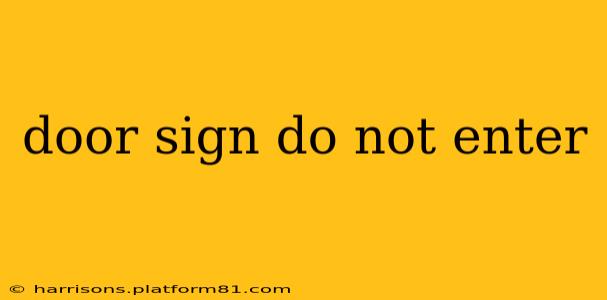A simple "Do Not Enter" sign might seem insignificant, but it carries significant legal and practical weight. These signs, ubiquitous in various settings, communicate crucial information and help maintain order, safety, and security. This guide delves into the world of "Do Not Enter" signs, exploring their types, uses, legal implications, and best practices.
What are the Different Types of "Do Not Enter" Signs?
"Do Not Enter" signs come in various shapes, sizes, and styles, reflecting the specific context and intended audience. Some common variations include:
-
Standard "Do Not Enter" signs: These typically feature bold red lettering on a white background, adhering to standard safety signage conventions. They are commonly used in general settings where access restriction is necessary.
-
Signs with additional information: These signs might include supplementary information such as reasons for the restriction (e.g., "Authorized Personnel Only," "Construction Zone," "Danger – High Voltage"). Adding specific details increases clarity and reduces potential confusion.
-
Graphic signs: Some signs incorporate visual elements like symbols or icons alongside the text, further enhancing understanding, especially in multilingual environments or for those with limited literacy. These often prove helpful in situations where immediate comprehension is crucial.
-
Temporary signs: These are commonly used for short-term restrictions, such as during construction or maintenance. They are often made of lightweight, easily removable materials.
What are the Legal Implications of "Do Not Enter" Signs?
The legal weight of a "Do Not Enter" sign depends heavily on context and jurisdiction. Generally, these signs serve as warnings, and ignoring them can have consequences ranging from minor infractions to serious legal repercussions.
-
Trespassing: Entering a designated area marked with a "Do Not Enter" sign can constitute trespassing, a civil or criminal offense depending on local laws and the circumstances. Private property owners have the right to exclude others, and a clearly posted sign strengthens their case.
-
Liability: Businesses and property owners have a duty of care to ensure the safety of those on their premises. Posting "Do Not Enter" signs in hazardous areas helps mitigate liability in case of accidents or injuries.
-
Enforcement: The enforcement of "Do Not Enter" signs can vary widely. In some instances, law enforcement might be involved, especially in situations involving serious safety risks or criminal activity. In others, private security personnel might be tasked with monitoring access.
Where are "Do Not Enter" Signs Commonly Used?
These signs are indispensable in numerous settings, ensuring safety and order:
-
Construction sites: Protecting workers and the public from hazards.
-
Hazardous areas: Preventing access to areas with dangerous machinery, chemicals, or other risks.
-
Private property: Maintaining the privacy and security of homes and businesses.
-
Restricted areas: Limiting access to sensitive locations, such as server rooms, laboratories, or government facilities.
-
Emergency situations: Directing people away from unsafe zones during emergencies.
What are Some Best Practices for Using "Do Not Enter" Signs?
Effective usage of "Do Not Enter" signs hinges on clarity, visibility, and appropriate placement:
-
Clear and concise wording: Use unambiguous language and avoid jargon.
-
High visibility: Ensure signs are easily seen, using bright colors and reflective materials where appropriate.
-
Proper placement: Place signs prominently at all entrances to the restricted area.
-
Consistency: Maintain consistency in signage throughout the property or facility.
-
Regular maintenance: Inspect signs regularly for damage or fading and replace them as needed.
What if a "Do Not Enter" Sign is Damaged or Missing?
If a "Do Not Enter" sign is damaged or missing, it's crucial to take immediate action to prevent unauthorized access and potential incidents. Report the issue to the relevant authorities or property management and replace the sign as soon as possible.
What is the difference between a "Do Not Enter" sign and a "No Entry" sign?
While often used interchangeably, "Do Not Enter" is generally considered more direct and imperative, leaving less room for misinterpretation than "No Entry." The choice often depends on the specific context and the desired level of emphasis.
Can I create my own "Do Not Enter" sign?
Yes, you can create your own, but ensure it meets relevant safety regulations and is clearly visible. Using standard colors and fonts is recommended to avoid confusion. However, it's always best to purchase professionally-made signs for optimal visibility and legal compliance.
By understanding the diverse applications, legal implications, and best practices associated with "Do Not Enter" signs, we can appreciate their crucial role in maintaining safety and order across various environments. The seemingly simple directive holds significant weight in ensuring a secure and well-managed space.
